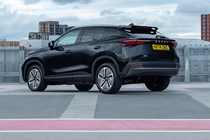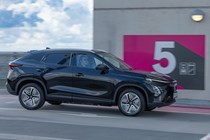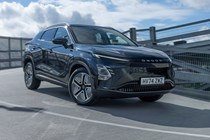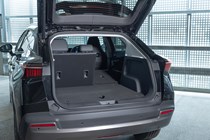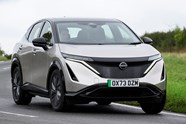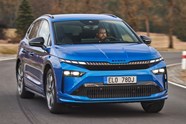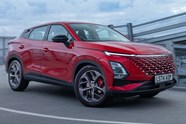OMODA E5 review

At a glance
| Price new | £33,065 - £34,565 |
|---|---|
| Used prices | £19,748 - £25,252 |
| Road tax cost | £195 |
| Insurance group | 34 - 35 |
Get an insurance quote with

|
|
| Fuel economy | 3.8 miles/kWh |
| Range | 257 miles |
| Miles per pound | 6.0 - 11.2 |
| Number of doors | 5 |
| View full specs for a specific version | |
Available fuel types
Fully electric
Pros & cons
- Good value EV with five-star Euro NCAP rating
- Real-world efficiency seems promising
- Better to drive than the petrol version
- Limited charging speed
- Dashboard not very user-friendly
- Small boot
OMODA E5 SUV rivals
Overview
The Omoda E5 is essentially the all-electric version of the Omoda 5, a family sized SUV from one of the increasing ranks of new Chinese brands launching into the UK. However, the firm says this zero-emissions model is ‘half a generation’ more advanced than the petrol variant, so it’s not just a case of swapping the fuel tank for a battery pack and removing the combustion engine under the bonnet.
The result is a more convincing car than the regular Omoda 5. And although the Omoda E5 won’t be troubling our list of the best electric SUVs, the £33,055 starting price is keen. For context, a Nissan Ariya – similarly sized and shaped – costs nearly £40,000 in its most basic version. The Leapmotor C10, another new Chinese electric SUV, starts at £36,500, while the excellent Skoda Enyaq costs from just under £37,000.
The Renault Scenic E-Tech is another key rival. This costs from around £37,500, presently, but is also the 2025 Parkers Car of the Year. So should be top of the shortlist.
Even so, consider the Omoda comes with a five-star Euro NCAP rating and a seven-year warranty. And that in our testing so far it appears to be reasonably efficient in real-world driving. This all adds up to an electric vehicle (EV) that seems well worth a closer look if you want to go greener on a tight budget. Find out more about how we test cars, or carry on to read the rest of our Omoda E5 review.
What’s it like inside?
While the bones of the thing are clearly related, there are a surprising number of differences between the Omoda 5 and E5. Both have a simple dashboard design with a couple of screens on the top, and both feature an unusual but nicely considered colour palette that’s backed-up but solid material and construction quality.
But the electric E5’s screens are 12.25-inch affairs – up from the petrol’s 10.25-inch basis – and the panel they sit within is slightly curved towards the driver. The gear selector is now a stalk mounted behind the steering wheel, rather than a conventional lever, and the decluttered centre console this leaves behind features a lidded cubby to hide your wirelessly charging phone within, rather than the open panel of the Omoda 5.
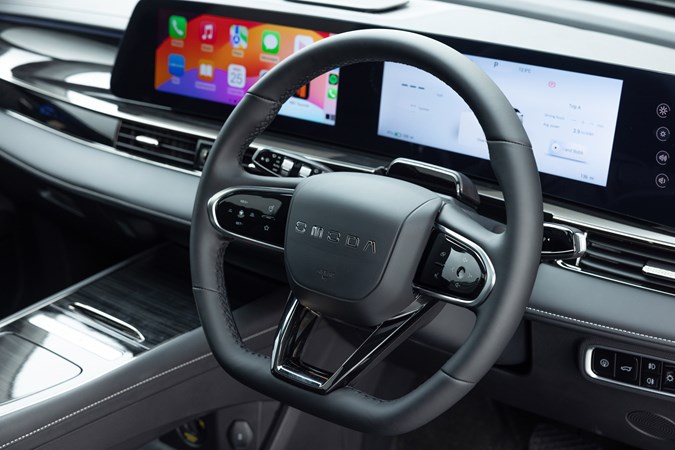
Clearly the idea was to make it seem that bit more modern. And unfortunately, we fear Omoda has gotten a little carried away. There are even fewer buttons – leaving things such as the air-conditioning more difficult to use – while the revised infotainment software and digital instrumentation is often too over-elaborate.
For instance, switching between driving modes triggers an animation that takes over the central screen for just that bit too long, and at times we struggled to find our way back through the menu system. The E5 also talks to you a lot, in addition to generating an impressively broad array of warning bongs.
Still, this is a spacious car for passengers, with a good amount of room for four adults (five will fit). The 380-litre boot matches the petrol car, but could really do with being larger for a vehicle of this size.
Range and charging
The Omoda E5 uses a 204hp electric motor – a familiar figure at this end of the electric market because it’s the equivalent of 150kW – to drive its front wheels. It’s powered by a 61kWh ‘blade’ battery pack, a type of design that’s said to improve crash safety.
Range, according to the official WLTP figures is 257 miles per charge, and the official efficiency rating is around 4.1 miles per kilowatt (mpk). In our testing so far, we’ve seen it manage between 3.3 and 3.7 mpk, which is a decent result in real-world driving.
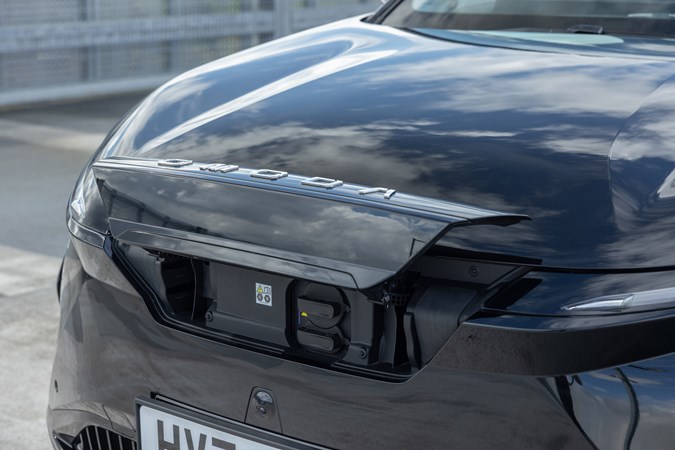
What’s less impressive is the charging speed, which is capped at a low 80kW. Cheekily, Omoda therefore quotes a ‘30-80%’ charging time – rather than the 10-80% that’s more common – and this still takes 28 minutes on the public charging network.
Expect to need at least 11 hours for a full charge on a standard 7kW home charger.
What’s it like to drive?
The electric motor is more powerful than the petrol engine Omoda uses, and delivers 340Nm of torque (pulling power) with typically instant EV eagerness. So although it’s 7.2-second 0-62mph time isn’t much faster on paper, it feels faster on the road. The torque can cause the front wheels to scrabble a little on slippery surfaces, and when you accelerate hard over crests the stability control comes in quite abruptly, but these are really the only major downsides to driving the electric version, by comparison.
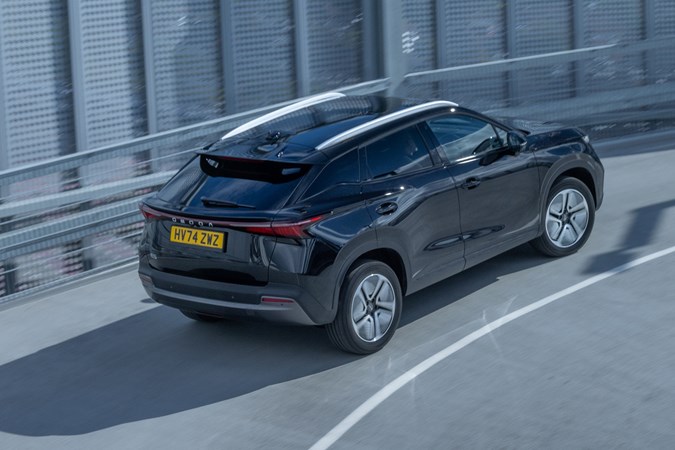
In all other respects, the E5 feels like a more mature product. The steering is nicer, and the suspension handles bumpier roads with less flightiness – the extra weight of the battery pack helping to quell some of the unwanted body movement present in the petrol car. Both of these improvements make it more satisfying and less tiring, allowing you to drive it more quickly, should you desire.
There’s still quite a bit of road noise, and the structure still feels rather wobbly, which is a surprise in a modern vehicle. We also found the brake energy regeneration system rather odd. As with most electric and hybrid cars, you can vary the amount the E5 slows down when you stop pressing on the accelerator, but you have to dive into the infotainment system to adjust it.

This is annoyingly faffy, but the regen is also rather ungainly in its behaviour. There are three settings – the first does basically nothing, while the second and third give so much straight away that we found ourselves going back onto the accelerator, causing a lurching motion as the regen process is immediately dropped.
This is not something we’ve experienced before, and some further calibration would go a long way towards making the process smoother. But we suspect most drivers will simply stick with the standard setting.
What models and trims are available?
There are two trim levels: Comfort and Noble. These have the same names but not exactly the same standard equipment as the petrol alternative.
Omoda E5 Comfort standard kit includes LED headlights, adaptive cruise control, blindspot monitors, 11 airbags, 50W wireless phone charging, front and rear parking sensors, reversing camera and keyless entry. Plus those twin 12.25-inch screens.
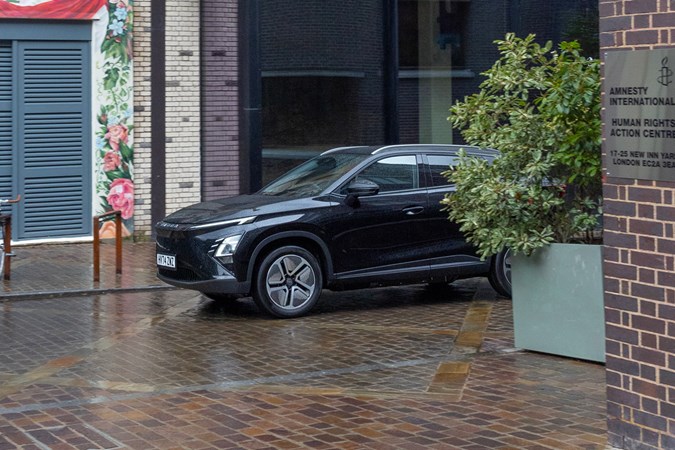
The Omoda E5 Noble adds an eight-speaker Sony sound system, 360-degree cameras, powered sunroof, powered tailgate, electric front seats, and additional air purification.
What else should I know?
Omoda is doing a convincing job of wanting to be helpful to UK buyers – it’s already established a 60-strong UK dealer network, with a total of around 100 dealers expected by the end of the year and another 20 or so planned for 2025. And it has UK parts warehouse, supported by DHL, in an effort to make sure customers won’t be left waiting for parts to arrive from China.
Insurance groupings are super low, but the firm is working with industry body Thatcham to improve repairability and reassure underwriters that the cars won’t be a major pain in the bottom to keep on the road should an accident happen.
Click through to our verdict to see if we think you should consider buying an Omoda E5.




